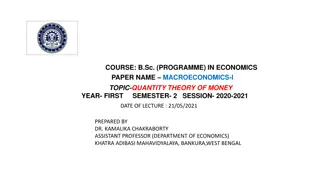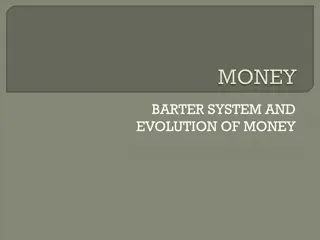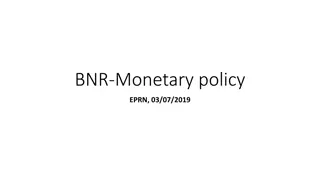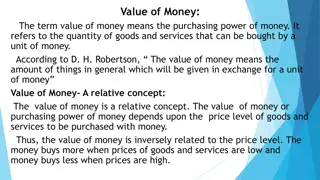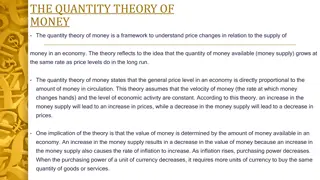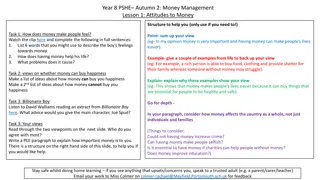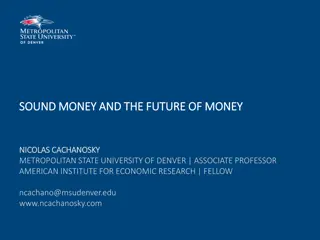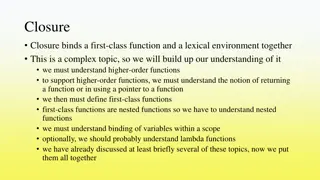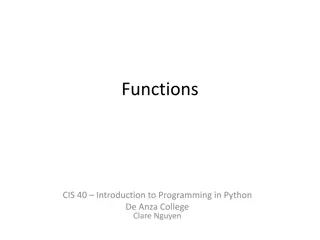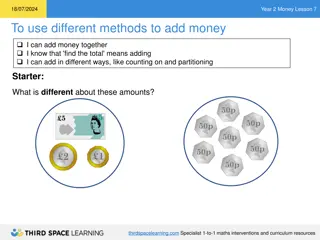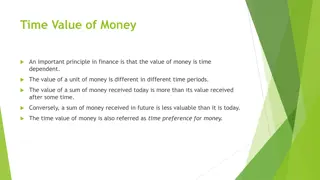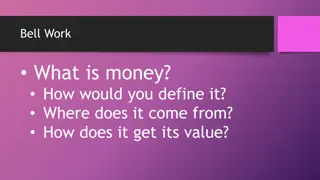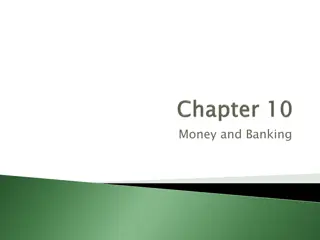Understanding Money: Functions, Properties, and Importance
Explore the essential aspects of money, including its functions as a medium of exchange, standard of value, and store of value. Discover the key properties of money such as durability, portability, divisibility, economic stability, scarcity, and acceptability. Uncover the historical evolution of money and its diverse forms throughout different times and regions. Gain insights into how money facilitates economic transactions and serves as a fundamental pillar of modern economies.
Download Presentation

Please find below an Image/Link to download the presentation.
The content on the website is provided AS IS for your information and personal use only. It may not be sold, licensed, or shared on other websites without obtaining consent from the author. Download presentation by click this link. If you encounter any issues during the download, it is possible that the publisher has removed the file from their server.
E N D
Presentation Transcript
Chapter 10: Money and Banking Section 1: Money: Its Functions and Properties pg.288-295
Key Concept At different times and places, cattle, corn, rice, salt, copper, gold, silver, seashells, stones, and whale teeth, have all been used as money. Money is anything that people will accept as payment for goods and services. Money should perform three important functions. http://www.factzoo.com/sites/all/img/mammals/orca-whale-teeth.jpg
Function 1 Money must serve as a medium of exchange, or the means through which goods and services can be exchanged. Without money, economic transactions must be made through barter exchanging goods and services for other goods and services. Money allows for the precise and flexible pricing of goods and services, making any economic transaction convenient. http://ecolan.sbs.ohio-state.edu/Aly/classes/powerpoint/ch13/sld004.jpg
Function 2 http://stephansmithfx.com/wp-content/uploads/2010/11/United-States-One-Dollar-Federal-Reserve-Note1.jpg Money also serves as a standard of value, the yardstick of economic worth in the exchange process. It allows people to measure the relative cost of goods and services. The basic monetary unit in the U.S. is the dollar, which serves as the standard by which the economic worth of all goods and services can be expressed and measured.
Function 3 Finally, money acts as a store of value, that is, something that holds its value over time. People, t/f, don t need to spend all of the money at once or in one place; they can put it aside for later use. People know it will be accepted wherever and whenever it is presented to purchase goods and services. http://a2.mzstatic.com/us/r30/Purple5/v4/ab/56/7c/ab567c2b-e74e-5f6a-71ec-c519f1d68947/screen480x480.jpeg
Properties of Money #1 The Physical http://news.coinupdate.com/wp-content/uploads/2015/02/coins.jpg Durability-the money should last Portability money needs to be small, light and easy to carry. Divisibility for example the dollar can be divided into pennies, nickels, dimes, or quarters. Uniformity money must be uniform, so it is more difficult to make counterfeit money.
Properties of Money #2 Economic https://timedotcom.files.wordpress.com/2014/06/201406_cou_g.jpg?quality=75strip=colorw=1100 Stability of Value Money s purchasing power, or value, should be relatively stable. Scarcity Money must be scarce to have any value. Acceptability People who use the money must agree that it is acceptable. In another words, they will accept money for goods and services b/c others will also accept it as payment.
Types of Money Money draws its value from three possible sources. Commodity Money derives its value from the type of material from which it is composed. Representative Money is paper backed by something tangible such as silver or gold that gives it value. Fiat Money has no tangible backing, but it is declared by the government that issues it, and accepted by citizens who use it, to have worth. http://images.wisegeek.com/rare-greek-silver-coins.jpg
Money in the Unites States http://st.depositphotos.com/1014014/2869/i/950/depositphotos_28690857-demand-deposits-road-sign-illustration.jpg In the narrowest sense, money consists of what can be used immediately for transitions currency, demand deposits, and other checkable deposits. Currency is paper money and coin. Checking accounts are called demand deposits b/c funds in checking accounts can be converted into currency on demand.
Are Savings Accounts Money? There are other monetary instruments that are almost, but not exactly, like money. Known as near money, it includes savings accounts and other similar time deposits that can t be used as a medium of exchange but can be converted into cash relatively easily. Time deposits are funds that people place in a bank for a specific period of time for a higher interest rate. These are called certificates of deposit or CDs. http://teenagersinvesting.weebly.com/uploads/1/8/6/8/18685558/7093449_orig.jpg
How Much Money is in Supply in the U.S.? http://image.slidesharecdn.com/econch14moneybanking-100107102220-phpapp01/95/econ-ch14-money-banking-8-728.jpg?cb=1262859792 Economists use various instruments to measure the money supply. The most often cited are M1 (1,368 Billion) and M2 (6,680 Billion). M1 is the narrowest measure of money supply. It consists of currency, demand deposits, and other checkable deposits. It is referred to as liquid assets, which means that they can easily become currency. M2 is a broader measure. It includes savings accounts, CDs, and money market mutual funds (Ch. 11). We will learn the importance of the money supply in chapter 16.


